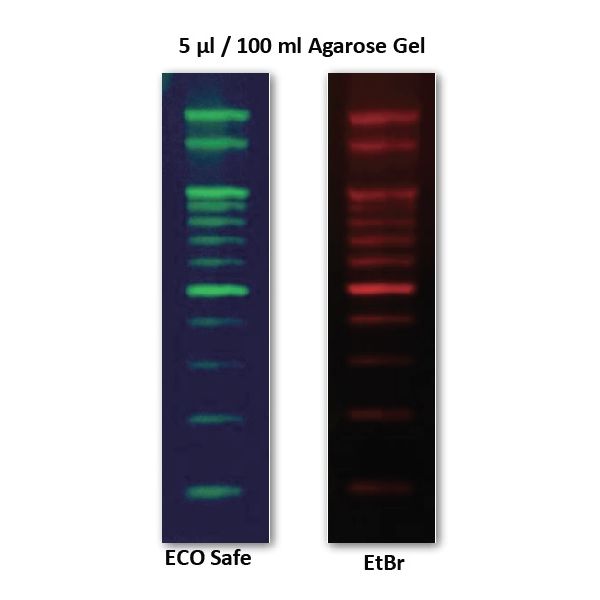ECO Safe Nucleic Acid Staining Solution, 1 ML, 20.000x, cod catalog DYT-FYD007
● High sensitivity: same as EtBr Stain in UV and blue light
● Safe: Non-mutagenic, non-toxic, non-carcinogenic Green: No hazardous waste.
● ECO Safe can be used by regular UV transilluminator as well as by Glite 965
● Cost Effective: use only 5 μl in 100 ml of agarose gel.
● Shipping condition : Room Temp. Store condition: 4°C in the dark
ECO Safe Nucleic Acid Staining Solution, 1 ML, 20.000x
Storage: Room Temp.
Description:
ECO Safe Nucleic Acid Staining Solution aims to replace traditional EtBr (ethidium bromide) in performing nucleic acid detection in agarose gels. EtBr has long been known as a strong mutagen, however ECO Safe causes only neglectable mutations in the Ames test.
The sensitivity of ECO Safe is identical to that of EtBr. Under UV light, ECO Safe emits green fluorescence when bound to DNA or RNA. ECO Safe can be excited at 285 nm and 500 nm. The fluorescence emission peak of ECO Safe when bound to DNA is at 537 nm
Protocol
5 μl / 100 ml Agarose Gel (20,000×, 1ml)
1. Heat the agarose gel solution in the microwave until the solution is completely clear.
2. Add ECO Safe Nucleic Acid Staining Solution (20,000×) to the agarose solution. (EtB“Out” : Agarose gel solution = 1 : 20,000)
3. Mix the solution gently without forming bubbles.
4. Wait until the solution is cooled down, pour it into the gel tray and allow the solution to solidify. (The optional thickness of the gel should be <0.5cm to avoid low sensitivity)
5. Perform electrophoresis and detect the result under UV illumination, green fluorescence bands are visible in the existence of nucleic acids. (DNA is observable under visible light when it is >50ng)
| Price | 450,00 RON (preturile sunt fara TVA) |
|---|---|
| Description |
ECO Safe Nucleic Acid Staining Solution, 1 ML, 20.000x
Storage: Room Temp. Description: ECO Safe Nucleic Acid Staining Solution aims to replace traditional EtBr (ethidium bromide) in performing nucleic acid detection in agarose gels. EtBr has long been known as a strong mutagen, however ECO Safe causes only neglectable mutations in the Ames test.
Protocol
|

 English
English



